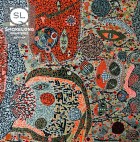I’m very intrigued by your main character’s arc, which, at first glance, moves in a seemingly unusual direction: At the beginning, she occupies a position of knowing, of being in full possession of the only tale she seems willing to tell, yet by the end she has reached a point of much less certainty, rattling off all the lingering questions regarding the story behind the story, if you will. To your way of thinking, what changes for the character over the course of this brief narrative? Is she forming these questions for the first time, or has she been carrying them with her for a while?
That’s a wonderful summary of her arc. I believe the character has been carrying these questions with her since the incident, hence the character’s feelings of isolation and her longing for someone who can perceive what she feels to be the truth of her tale. The story suggests an ongoing struggle to make this connection, perhaps partially fueled by the unforgiving parameters of the test the character uses to judge those around her. What makes this a pressing and revealing moment for the character and the reader is the shift towards ambiguity you mentioned: the realization that there may lie at the center of the character’s experience of the incident a mystery she herself cannot fully access. She is left with her questions and the urgent sense that she may not be able to capture this feeling in language.
On a related note, the main character places a tremendous amount of importance on the simple act of asking questions: She’s greatly disappointed in the person at the party who fails to inquire about how she lost the tip of her finger, showing interest only in the pain itself. She declares this a failed “deciding test” as to whether or not this other person will become a “true friend.” She even blames some question from her mother for inspiring the original injury. In your mind, what does the character see as the connection between the mother’s and the fellow partygoer’s respective offenses?
There are many connections for the character, but I believe one common thread is the question of whether she feels fully seen or understood by those closest to her.
It’s worth noting that pretty much all of the character interactions end up being derailed by some degree of misunderstanding, egocentrism, or ulterior motives. As you see it, who or what is to blame for the general disconnect between the various characters? Does the fault lie with the main character or the others? Is this disconnect limited to this story, or does this echo something you observe throughout modern society?
As you point out, there are several obstacles facing the characters, which make it difficult to provide a simple answer. The challenge of meaningful connection does permeate the story, and the problem is intrapersonal as well as interpersonal. I’ve been writing stories recently about characters who close themselves off more tightly in their journeys. The main character here is no exception—note how the word “friend” is used and where it disappears in the story, for example. Though she makes the effort to share her tale and crucially hopes and longs for the potential connection it might bring, there remains a resistance that also undermines the gesture.
I am also intrigued by your selective use of comparison: One simile involves the partygoer’s insufficient question being equated to “a crane skewering a slow fish,” while the other describes the main character’s emotional response to intentionally injuring herself as resembling the twitch of a fish’s tale. What does the fish represent in these two instances? What was your thematic intent with these comparisons?
In a story this short, it helps to be selective with comparisons; compression invites extremely close attention to language, and in that style of reading, the significance of even a single image, repeated once, becomes more pressing. In the first instance, when the main character’s companion fails her test, the fish appears as a kind of symbol of the latter’s failure to catch the truth at the heart of the tale. In the second instance, the image moves within the character, suggesting perhaps that her own grasp of the tale, upon deeper reflection, might be just as uncertain.
Finally, I would describe your story as emotionally expansive, which is all the more impressive considering its obvious brevity. Do you have a consistent strategy for translating complex ideas into such a concentrated form? Is there something about flash fiction, specifically, that lends itself to this approach?
Human truths are often contradictory, and writing towards mystery is a consistent strategy that I’ve found helps suggest meanings that can transcend the limits of language or word count. B.J. Hollars, in a recent interview with The Millions about his book Midwestern Strange, offered a great quote about revelation and mystery: “Mysteries aren’t something to be solved but something to be embraced. We don’t need to conquer; we just need to be curious. For me, that’s where the revelation lives—in the not-knowing.” The enduring power of mysteries is that they are clearly observed, not explained. Flash fiction is well suited to this style of observation, since it relies so much on either what is absent or not directly confronted on the page.



 The SmokeLong Grand Micro Contest (The Mikey) is now an annual competition celebrating and compensating the best micro fiction and nonfiction online.
The SmokeLong Grand Micro Contest (The Mikey) is now an annual competition celebrating and compensating the best micro fiction and nonfiction online.